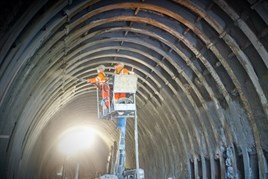Once the old lining was removed, new pre-cast concrete invert units could be installed, followed by 305mm x 305mm steel reinforcing ribs that each weigh around 41⁄2 tonnes. The ribs were built inside the tunnel from three sections, and lifted into position as a single unit by specialist equipment that AMCO designed specifically for the project. Each rib was then bolted into place.
As the removal and replacement of ribs progressed, a team worked from behind to apply a new fibre-reinforced concrete lining to the tunnel. A 420mm-thick layer of concrete was spray applied. But this is not just standard concrete, it contains additives that give it strength, flexibility and workability, as well as a chemical that retards curing to allow the concrete to be transported into the tunnel and pumped into position before beginning to set.
While the main reconstruction was progressing at the Todmorden end of the tunnel, teams were also making repairs at the Burnley end.
Bricklayers and stonemasons were on site 24 hours a day, repairing the old lining. In some areas, this meant reusing stone recovered from work at the other end of the tunnel to replace the damaged stone. Grouting work at the Burnley end will prevent future water ingress.
The main repair and reconstruction work was completed by early March 2014. The site was then handed over to Stobart Rail, which reinstated the track infrastructure. By March 24, the line re-opened to service traffic as planned.
With any major engineering work, there is a high level of risk involved. What is perhaps most impressive about the work at Holme Tunnel is that there were no workforce accidents.
At the project’s peak during the blockade, 110 staff were on site every day over two shifts, working in a hostile underground environment. But they all remained safe. It is testament to the skills and expertise of NR and the engineering, mining and tunnelling experience of AMCO that this was possible.
And the project wasn’t just delivered on time and on budget, without compromising any aspect of the work, it also saved more than £1 million from the original budget, coming it at around £11.5m.
The benefits for the railway long-term are huge. Not only has the line speed been increased from 20mph to 45mph, the blockade during the project allowed for a whole suite of additional works to be carried out on a further ten miles of the route.
None of that would have been possible without the collaborative teamwork between NR and AMCO. And nothing really sums up that achievement better than a comment from one of the Office of Rail Regulation inspectors:
“If we could bottle what’s happening here, I’d be out of a job.”
- This feature was published in RAIL 763 on 10 December 2014














Login to comment
Comments
No comments have been made yet.